Dehorning of calves
Learn about cattle horns and how to humanely remove them from calves.
ISSN 1198-712X, Published November 2022
Horns and their growth
Horns are the hard, bonelike, permanent growths projecting from the heads of cattle. They grow from a unique area of skin cells at the base of the horn.
At about 2 months of age, horns become attached to the frontal bone of the skull. A sinus (cavity) lies within the skull beneath the horn bud.
As the horn grows and attaches to the skull, this frontal sinus joins into the adjacent portion of the horn. A scur is an incompletely developed horn growth, usually not attached to the skull.
Disbudding and dehorning defined
Horned cattle have horns because they have not been dehorned or they are not polled. Some cattle are naturally (genetically) hornless; animals born without horns are called polled. Dehorning of horned cattle is the process of removing their horns or the process of preventing their growth.
Disbudding by chemical or hot-iron destroys the horn-producing cells of the horn bud before the horn bud attaches to the skull and horns have formed from the bud. Surgical disbudding removes the horn bud and the horn-producing cells of the horn bud. Dehorning removes the horn and horn‑producing tissue after horns have formed from the bud and are attached to the skull.
Reasons for dehorning
Dehorning of young calves is recommended to:
- reduce the risk of injury and bruising to herd mates
- prevent financial losses from trimming damaged carcasses caused by horned feedlot cattle during transport to slaughter
- require less space at the feed bunk and in transit
- gain a price advantage by offering hornless cattle at auction
- produce docile cattle that are easier to handle
- decrease aggressiveness at the feed bunk
- enhance on-farm safety for animals, producers and employees
- facilitate easier use of handling facilities
Managing horned cattle
Owners may choose to manage their cattle with or without horns. For beef cattle, the selection will depend on the available handling facilities, the producer’s ability, the awareness of dehorning effects and the market available for the calves. Preconditioned (castrated, dehorned, vaccinated, bunk-adjusted) calves may bring a premium price. Generally, horned cattle are discounted at auction, as purchasers are aware of the risks associated with processing older calves.
For dairy cattle, naturally polled animals are very rare. Therefore, dehorning is a common management practice on dairy farms. In Ontario, housing systems and milking parlours are designed for dehorned cattle. If dairy producers choose to work with horned cattle, housing and feeding equipment designs must accommodate dairy cattle with horns.
Breeding horns off cattle
Dehorning requires labour and imparts risks to the animal and the operator. In addition, producers and consumers have concerns about animal welfare implications associated with dehorning techniques. Breeding polled cattle is a non-invasive way to dehorn the cattle population.
Polled inheritance is very complex. Nonetheless, the beef industry is making steady progress towards reducing the need for dehorning through genetics. Producers may resist breeding strategies to dehorn because of a belief that the polled gene is associated with impaired productivity. To date, research studies show no difference for several important traits between horned and polled beef cattle. Within the beef breeds, producers have access to homozygous polled genetics, eliminating the need for dehorning without affecting productivity.
Homozygous bulls have two copies of the polled gene and therefore always pass on a polled gene to their offspring. Heterozygous bulls have only one copy of the polled gene and have a 50% chance of passing that on. Scurs, incomplete horn growths, are also genetic and can be expressed in polled cattle. Recent Ontario beef producer surveys report 86% of cow/calf producers have more than 75% polled calves.
The availability of genetically polled breeding bulls within the dairy breeds is limited but increasing. Commercially available genetic tests using genomic technology now allow for producers to identify animals carrying the polled gene to breed toward more polled animals in the herd. Researchers are investigating how gene editing can be used to produce high-genetic merit polled sires.
The prevention of horns by genetic selection is the most welfare-friendly technique and the use of polled sires within the beef industry in Canada continues to be promoted. The use of a naturally polled bull from naturally polled ancestors over horned breeding cows should result in the birth of polled calves. Continuous use of polled bulls over these female offspring should ensure that all calves continue to be polled. This method has obvious advantages where polled breeds are available with production characteristics similar to those of horned cattle.
Dehorning age
Dehorning at a young age minimizes hazards to the calf, the dairy or cow-calf producer, and the feedlot owner. Hazards for calves and owners include:
- infection or death following dehorning of older calves
- decreased liveweight gains in the weeks following dehorning of older calves
- loss of productivity
Many producers choose to dehorn very young calves because:
- techniques are easier for the operator
- dehorning is less stressful on newborn calves
- they are concerned for the animals’ welfare
Although there is no evidence that pain differs between young and older calves and both require pain mitigation, there is less risk with dehorning of young (less than 8 weeks) calves.
The cow/calf producer’s decision to dehorn and the timing (age) will be influenced by his or her facility, available labour, expertise with the techniques, awareness of the impact of the procedure on calf health and productivity, and market for the calves. In general, dairy calves receive intensive care and producers have an opportunity to dehorn their calves at a young age. It is each owner’s responsibility to ensure humane and safe completion of the dehorning procedure on the calves entrusted to their care.
The Canadian Veterinary Medical Association (CVMA) recommends that, when dehorning is necessary, it be performed within the first month of life.
Timing of operations
Normal management procedures provide a convenient time for dehorning. At one day of age, insertion of an identification ear tag and injection of the calf with vitamin E-selenium dictates that the calf be restrained. Disbudding can be performed at the same time. Some beef producers prefer to batch the calves up weekly during calving season and dehorn many at one time. Others will catch all calves prior to turning them to grass with their mothers. This may be when calves are 6–8 weeks of age and would also be an ideal time to administer the second injection of vitamin E-selenium.
Dehorning at an early age (less than 8 weeks) reduces the risk of serious infection because the horn bud is removed without opening the sinus (cavity) into the skull. When surgically dehorning older calves, the sinus is opened. On dairy farms, calves may be dehorned by a veterinarian or veterinary technician during the regular herd health visit. Targeted veterinary visits may also be arranged on beef farms to complete dehorning.
The risk of infection and fly strike is greater in the summer and autumn periods, particularly if dehorning older animals. If larger horns must be removed, the early spring, late fall or winter are preferred.
On each farm, the timing of dehorning will be based on the management system in operation. Dehorning at a young age should suit most management systems.
Economic significance
At packing plants, trim from bruised carcasses of animals in groups with horned cattle is twice that of comparable groups of hornless cattle. According to the Canadian Beef Quality Audit, bruising costs the industry $5.5 million a year or $1.90/head. There are also additional costs for horn removal at the packing plant. Dehorned cattle may incur fewer financial penalties at sale.
Welfare significance
Livestock owners and veterinarians recognize that some people consider dehorning undesirable. Nonetheless, dehorned cattle create a safer environment for herdmates, handlers and workers — a benefit that outweighs the short period of discomfort at dehorning time.
Consider the following:
- All methods of physical dehorning cause pain and side effects.
- Young calves recover quicker and have fewer complications than older calves.
- There is no evidence to show young calves experience less pain than older calves.
- Local anaesthesia prior to dehorning eliminates acute pain for a few hours after dehorning.
- The use of non-steroidal anti-inflammatory drugs (NSAIDs) as an analgesic (pain reliever) in combination with local anaesthesia provides longer lasting pain relief.
- Dehorning without anaesthesia is inhumane and unethical.
- In canada, there are several different labelled drugs to provide anaesthesia and pain relief for the disbudding or dehorning procedure available by veterinary prescription.
- Control of bleeding is essential when dehorning older calves.
- Wounds from disbudding or dehorning remain painful during healing. Limit feeding has been shown to slow wound healing.
- Use of polled bulls is a welfare-friendly alternative to dehorning. Canadian beef producers are increasing their use of polled bulls.
Anaesthesia and pain relief
Disbudding or dehorning without anaesthesia is associated with stress and pain for cattle and raises concerns for animal welfare. Medications that provide anaesthesia and pain relief include:
- a short-acting, local anaesthetic (such as lidocaine) with an effect for about 60–180 minutes
- an NSAID (such as ketoprofen, meloxicam, flunixin) to control pain and inflammation
- a combination of local anaesthetic and an NSAID provides pain control of longer duration, can safely be administered with a low risk for adverse effects, and is recommended for all cattle undergoing dehorning
- a sedative (alpha-2 agonist, for example, xylazine) given in conjunction with a local anaesthetic and NSAID can reduce the need for physical restraint during dehorning but does not provide continuing pain relief and may have carryover effects that delay suckling and return to play behaviour
Sedated cattle require additional monitoring to safely manage the animal’s health and oversight by a veterinarian.
Treatment with an analgesic alone prior to disbudding (dehorning) with caustic paste is not effective in controlling pain. Treatment with a local anaesthetic and NSAID is recommended regardless of the disbudding or dehorning method.
Any medications given must be recorded and appropriate withdrawals observed.
Blocking the nerve to the horn
The cornual nerve supplies sensation to the horn. This nerve travels from immediately behind the eye to the base of the horn. It lies underneath a small overhanging ledge of bone that is a part of the skull. This ledge is easily detected with slight finger pressure. A vein and an artery are found in association with the nerve. One nerve provides feeling to each horn, therefore the nerve must be blocked on each side of the head. Administration of the anaesthetic is simple in young calves. Many veterinarians train their clients in the technique.
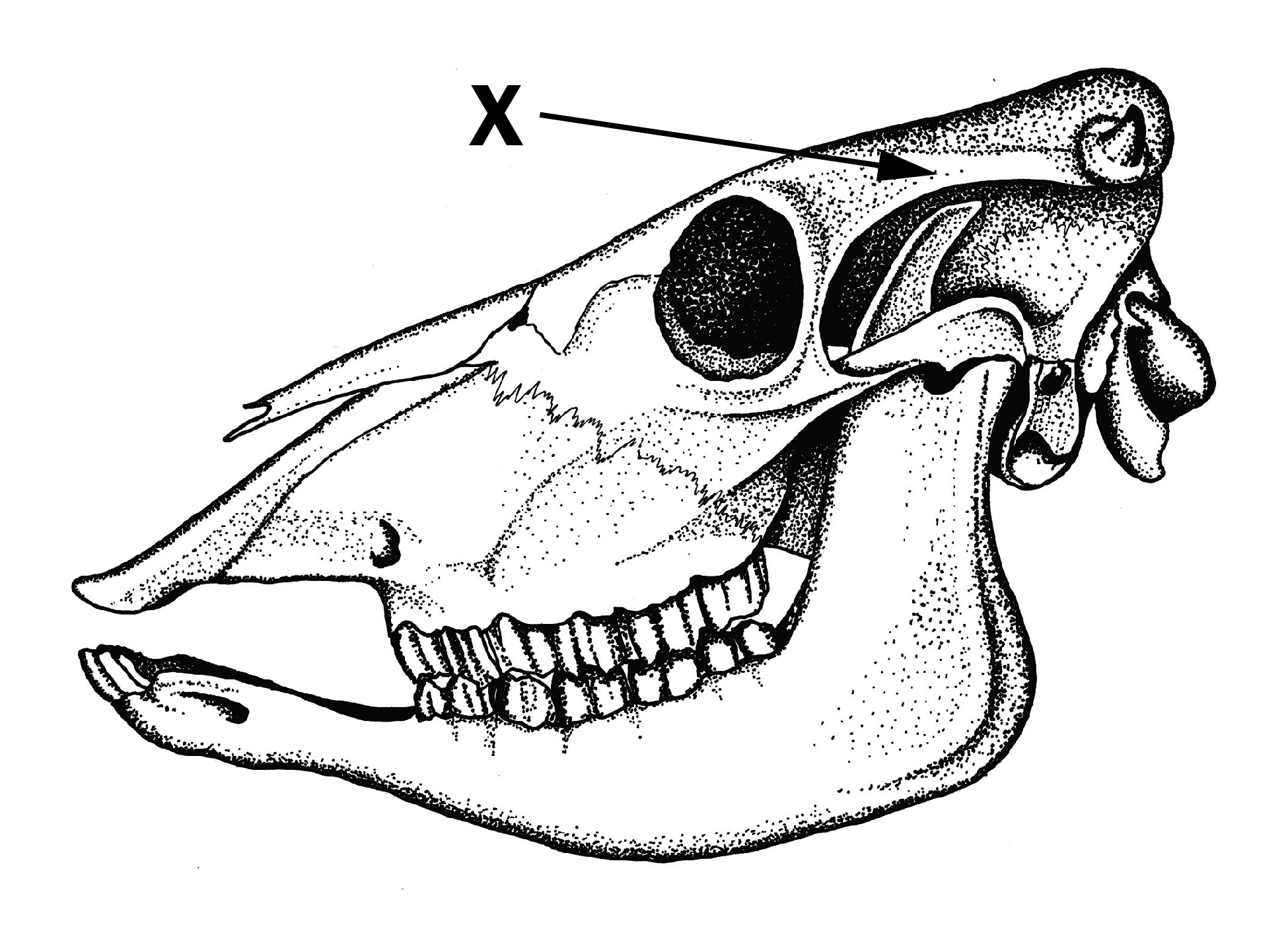
Blocking the nerve makes dehorning easier on the calf and on the person doing the job. Lidocaine anaesthetic is a prescription drug and is only available from your herd veterinarian. This procedure requires clinical training and practical experience. Local anaesthetic should be given by a veterinarian, a trained veterinary technician or a trained operator.
Technique
- Restrain the calf with a halter tied to a ring, a post or the head gate of the chute.
- Administer NSAID and if sedation will be used, sedate the calf with an appropriate dose as per label directions.
- Locate the injection site (Figure 1) for the local anaesthetic by putting your thumb on the skin just beside the outside corner of the eye. You will feel a soft depression at this site. Now, move your thumb backwards toward the horn. You will feel a small groove that runs in the bone of the skull. The nerve runs along and under this groove. The injection site is in the upper third (closer to the horn bud) between the corner of the eye and the base of the horn.
- Disinfect the site with an alcohol swab.
- Use a 20- or 18-gauge, 1–11⁄2-in. needle.
- Use a 6 or 10 mL syringe.
- Use from 3–10 mL of 2% lidocaine for each horn. The volume depends on the size of the calf.
- While holding the head steady and with the needle on the syringe, push the needle through the skin at the injection site. The needle should penetrate perpendicular to the skull at the site. Once you are through the skin, pull back on the plunger to be sure the needle is not in a blood vessel; then inject about 1.5 mL of lidocaine. Push the needle in about 0.5 cm and inject another 1.5 mL. Push it in about another 0.5 cm and inject the remaining lidocaine. Then withdraw the needle. If you hit the bone with the tip of the needle, withdraw it slightly and give the last of the lidocaine.
- Repeat on the other side of the head.
- Wait several minutes for it to take effect. The upper eyelid usually droops with correct injection techniques. The block may not be effective if the injection went too deep at the site.
- Proceed to block the nerves on other calves using a new needle for each calf and then return to dehorn the first calf. A properly administered block should last at least 60 minutes.
Dehorning methods
The choices of dehorning techniques range from genetic to surgical. The risks to the calf and the operator vary with each technique. Many producers choose to dehorn newborn calves because the techniques are easier for the operator, less stressful on the calves and they demonstrate concern for the animals’ welfare. Following are the common dehorning methods.
Polled bulls
Horned or polled cows mated to a naturally polled bull (Angus) will give birth to polled calves. However, some non-naturally polled bulls carry the gene for horns and will not breed true for the polled trait.
Considerations
- welfare-friendly
- availability of genetics for a specific beef or dairy breed
- occasionally scurs, a small hornlike formation, occur in some cattle when breeding polled cattle
Chemical dehorning
Caustic chemicals will prevent the growth of horns when properly applied to the horn buds of newborn (less than 3 weeks of age) calves. The chemical destroys the horn-producing cells around the horn bud. The chemicals are available as sticks or pastes applied with an applicator or by a squeeze bottle (Figure 2). To protect yourself, wear gloves when applying the chemicals. To protect the calf, avoid application near its eyes. Do not use caustics in rainy weather.
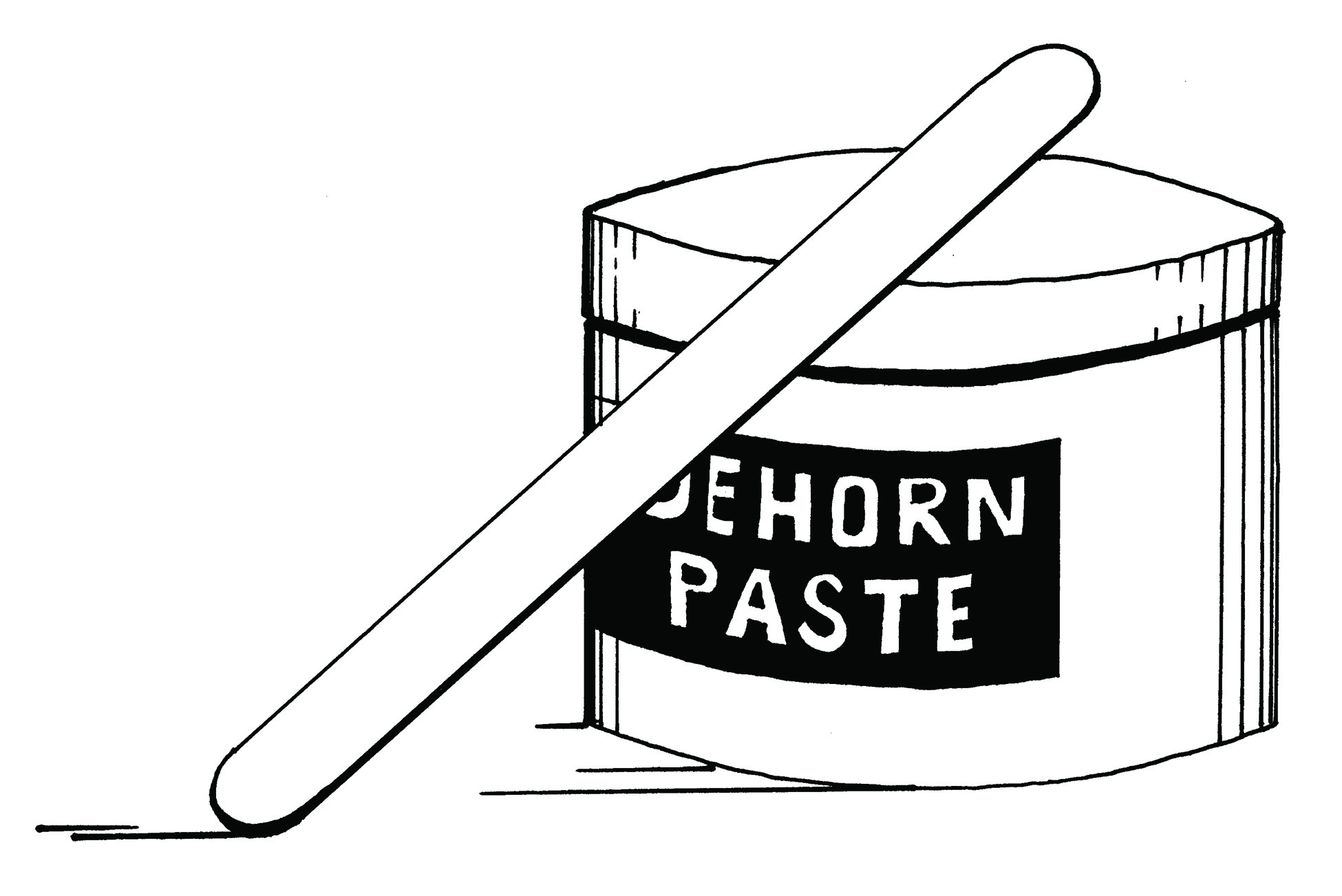
Technique
- Administer sedation, analgesia and local anaesthetic as directed by the herd veterinarian.
- Expose the horn bud (about the size of a 5-cent piece) by pushing the hair back (Figure 3).
- Apply the caustic to the horn button using an applicator. Apply a thin layer.
- Cover the horn bud by repositioning the hair over the paste and horn bud.
- Most package inserts instruct operators to clip hair at the horn bud. Experienced operators have found that minimal hair clipping is preferable because the surrounding hair keeps the caustic in place, reduces the risk of irritation to the cow’s udder and flanks and reduces irritation to other facial skin of the calf. Petroleum jelly can also be applied in a ring around the horn bud to keep caustic paste in the appropriate area.
- Protect the calf and the cow from accidental caustic burns. One method is to place a patch of duct tape over each horn bud. The duct tape usually falls off in a few days. Keep dairy calves in individual pens until the paste has completely dried. If paste is applied to an inappropriate area, rinse with water and apply vinegar to neutralize the caustic paste.
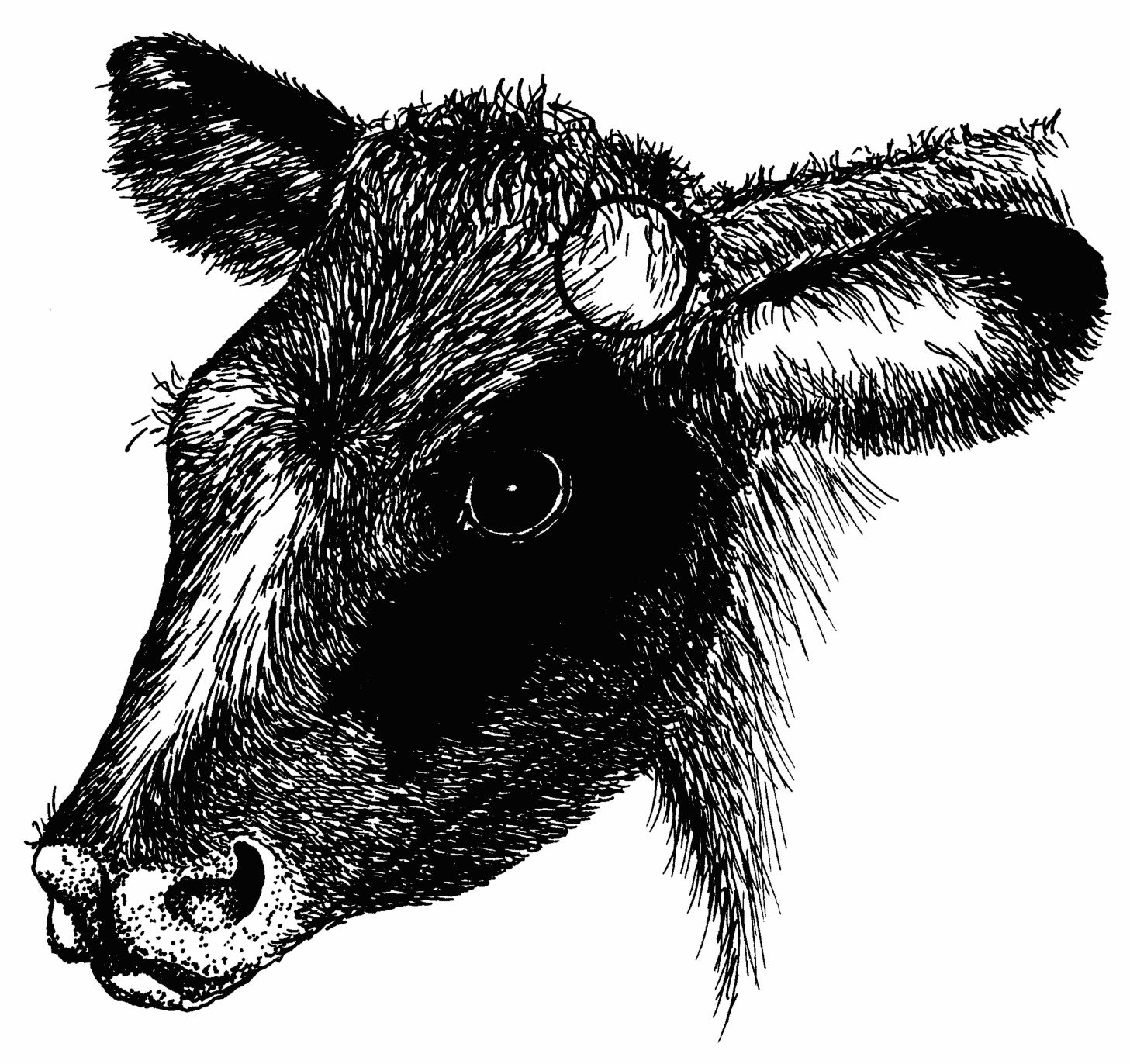
Considerations
- performed at a young age with less stress than some other techniques
- bloodless
- use in any season
- do not use in rainy weather
- prevent exposure to other animals until paste is completely dry, approximately 6 hours
- avoid contact with eyes; operator should wear gloves
- horns or scurs follow improper technique
- painful without anaesthesia
- requires pain control
Hot iron dehorning
Hot iron dehorners are available in versions heated by a 12-volt battery, 120-volt electricity, power packs (such as Buddex™) or LP gas (Figure 4). The head of the iron is a hollow circle and it fits over the horn bud. Proper application of the hot iron will destroy the horn-producing skin at the base of the horn. This technique works well for calves up to 12 weeks old. There are several sizes of dehorning irons. The proper size is one where the burner makes a complete ring around the base of the horn. For electric irons, use a short extension cord as voltage drops with a long cord, limiting the amount of heat generated by the dehorner.
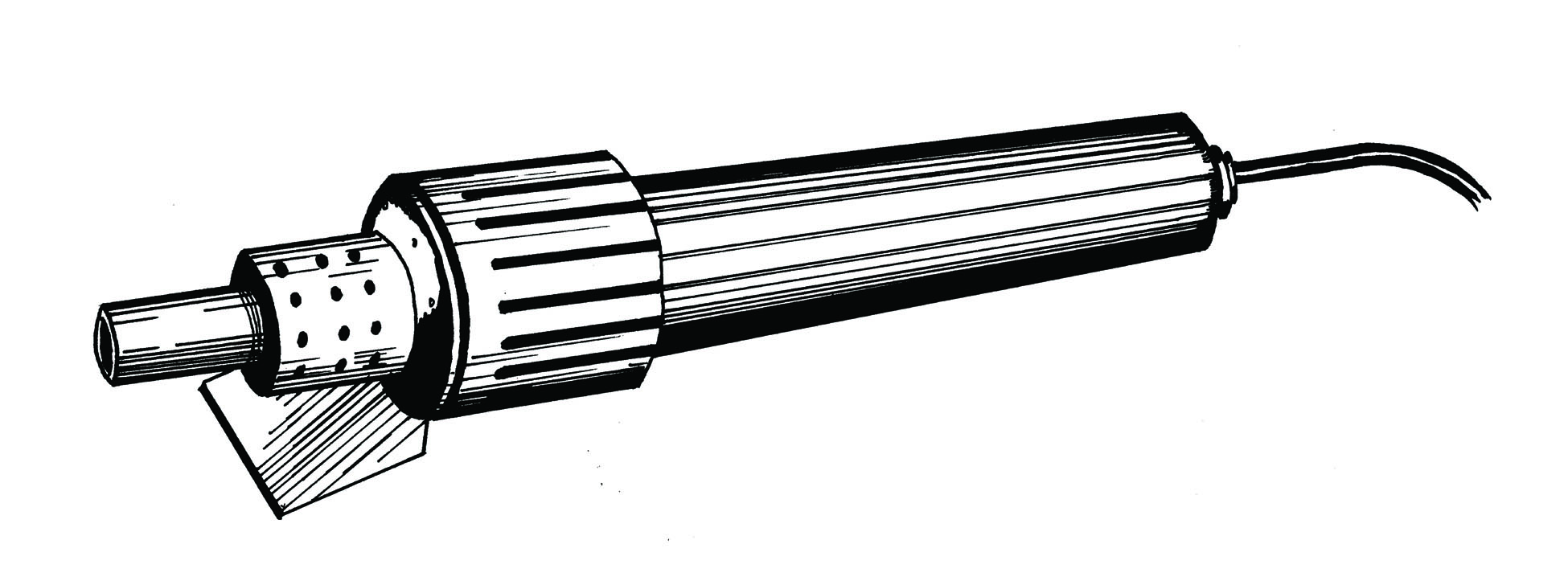
Technique
- Administer sedation, analgesia and local anaesthetic as directed by the herd veterinarian.
- Preheat the dehorning iron to a red colour. both electric and gas irons work best when they are “red” hot.
- Wear gloves to protect your hands.
- Hold the calf’s ear out of the way to keep it from being burned.
- Place the tip of the burner over the horn and apply slight pressure. when the burning hair begins to smoke, slowly rotate the dehorner by twisting your wrist.
- Continue the application of heat for 10–15 seconds. do not leave the dehorner in place for much longer, especially in young calves.
- Dehorning is complete when there is a copper-coloured ring all the way around the base of the horn.
- The horn bud or button will slough off in 4–6 weeks.
Considerations
- bloodless
- can be used at any time of the year
- young calves up to 12 weeks of age
- leads to scurs (partial horn growth) if done incorrectly
- requires expertise in pain control and technique
Dehorning spoon or tube
Dehorning spoons or tubes provide a quick and efficient technique for removing horn buds in calves less than 8 weeks of age (Figure 5). With this method, a sharpened metal tube cuts through and removes the horn-producing skin at the base of the horn bud. Use the proper size tube to remove the horn plus about ⅛ in. of skin around the entire horn bud.
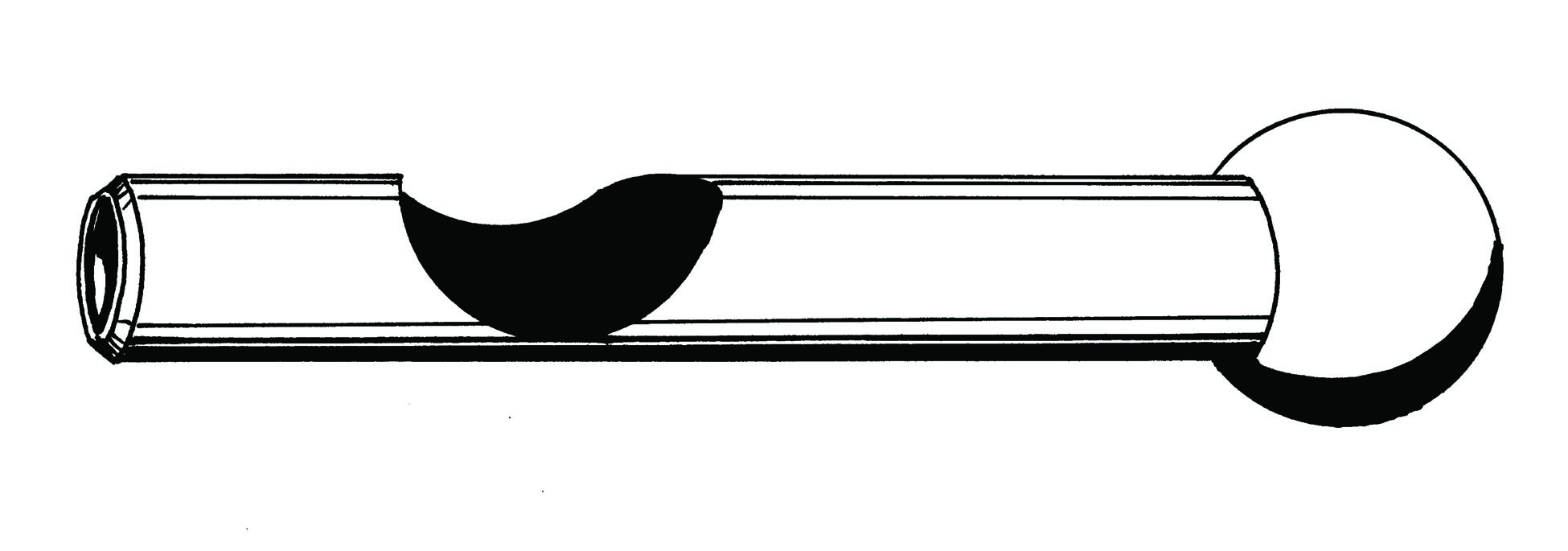
Technique
- Administer sedation, analgesia and local anaesthetic as directed by the herd veterinarian.
- Select the correct size tube (4 sizes available) to fit over the horn bud, and cover about ⅛ in. of skin around the horn base.
- Place the cutting edge straight down over the horn.
- Apply pressure to the tube; push and twist the tube until the skin has been cut through.
- Cut under the horn bud and remove it, using a scooping motion.
- Apply an antiseptic to the wound. some bleeding may occur.
- Clean and disinfect the cutting edge of the tube between calves.
Considerations
- bleeding may occur
- useful for young calves
- risk of infection because of open wounds
- avoid use during fly season
- leads to scurs if done incorrectly
- requires expertise in pain control, technique, control of bleeding
Scoop, gouge or barnes-type dehorner
Scoop dehorners are used for calves ranging in age from 2–4 months with horns up to 4 in. long (Figure 6). Some operators claim better dehorning with a rectangular-shaped scoop because it removes an even ring of skin around and with the horn bud. When used properly, it does not go too deep, but the dehorner can open the frontal sinus when used at the top end of the age and horn-size range. The blades must be kept sharp for best results.
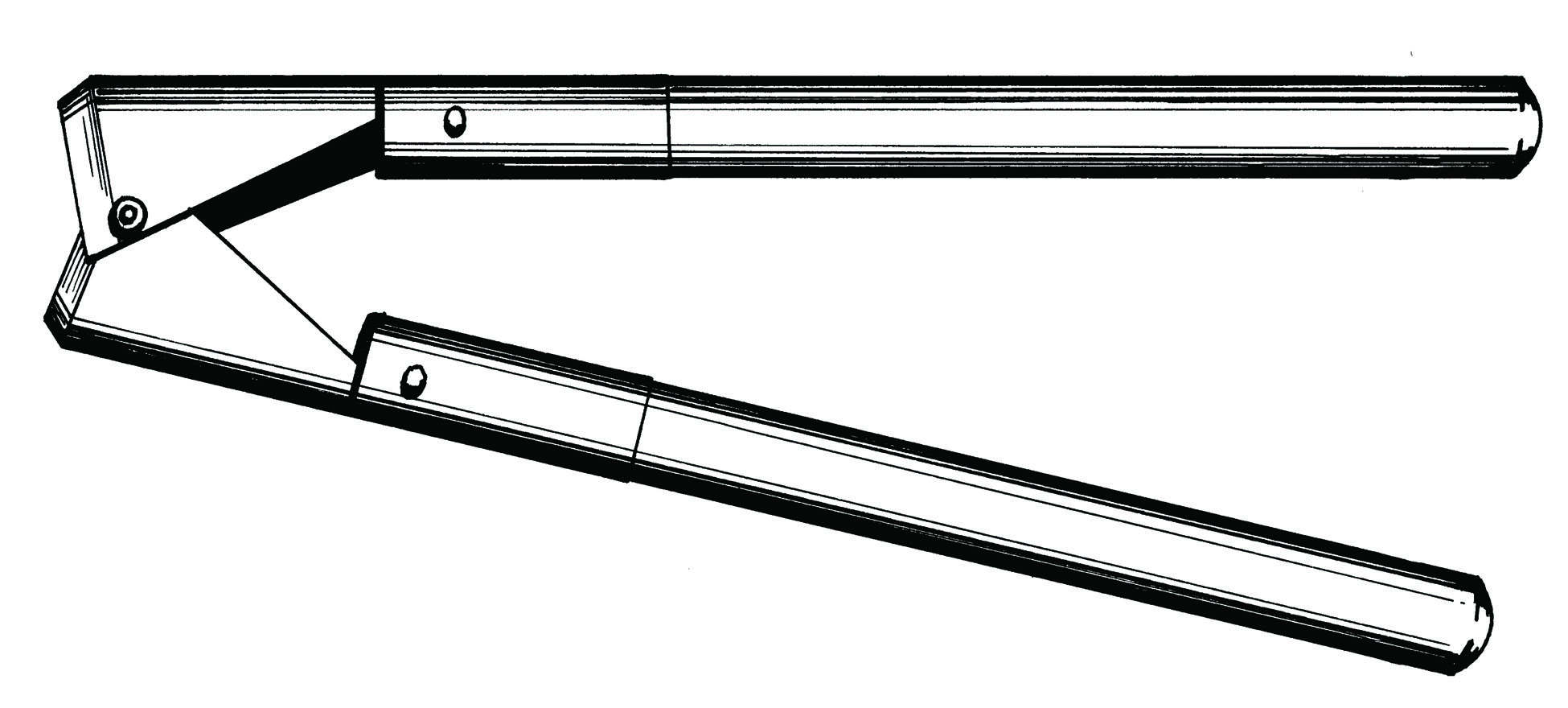
Technique
- Administer sedation, analgesia and local anaesthetic as directed by the herd veterinarian.
- Close the handles together.
- Place the jaws of the dehorner over the horn bud. adjust the opening as needed to completely remove a ring of skin surrounding the horn base (Figure 7).
- Press the gouger gently against the head. maintain the pressure and quickly spread the handles apart to bring the blades together to remove skin and the horn bud.
- Control bleeding by pulling the artery with forceps or using a hot iron to cauterize the artery.
- Clean and disinfect the jaws of the gouger between calves.
Considerations
- fast — takes a few seconds to perform
- appropriate only after the horn bud attaches to the skull
- bleeding may occur
- risk of infection because of open wounds
- opens the frontal sinus in older calves
- avoid use during fly season
- leads to scurs if done incorrectly
- requires expertise in anaesthesia, sedation, analgesia and technique
- requires control of bleeding — pulling arteries or cautery
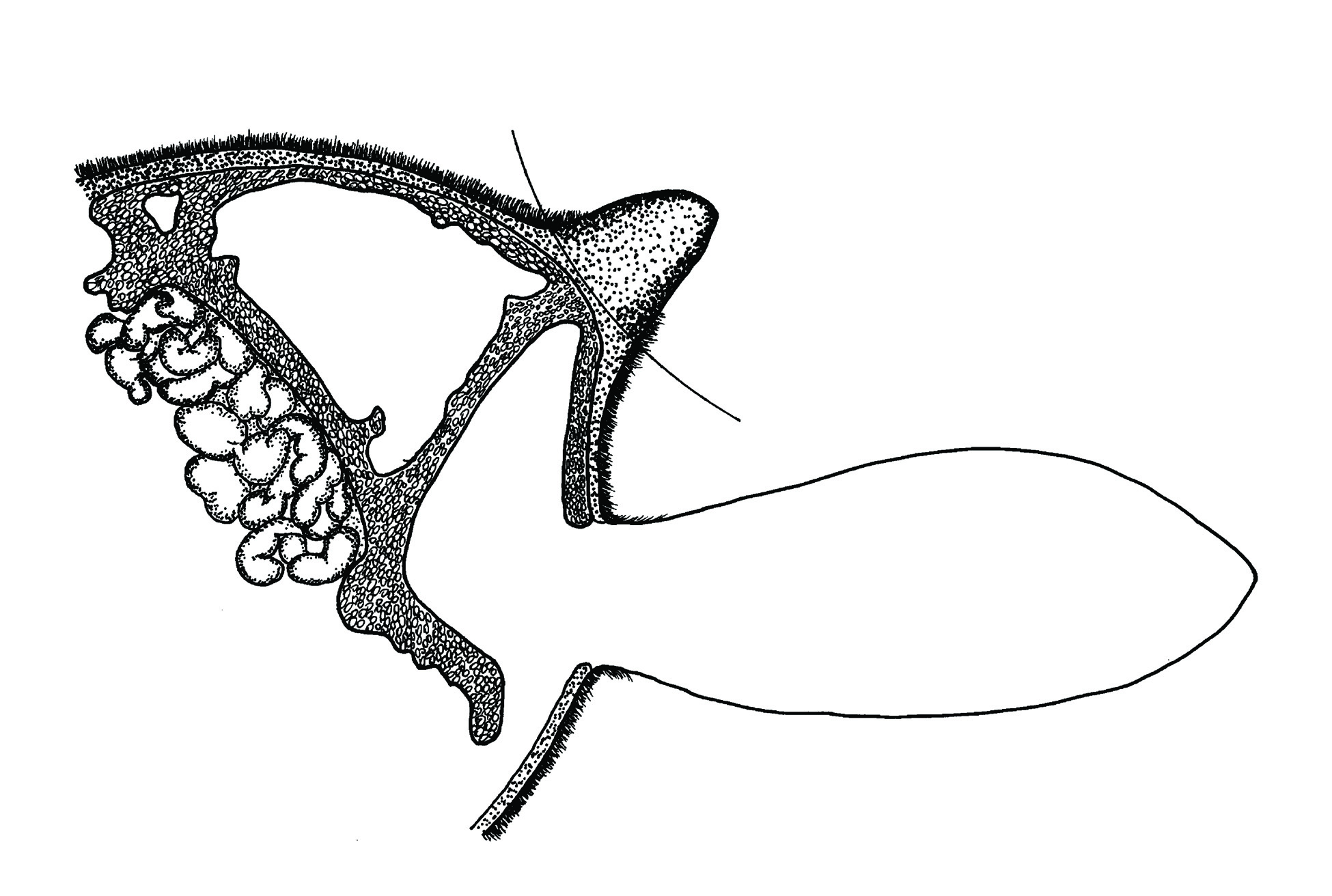
Aftercare
Dehorning and disbudding are surgical procedures. Calves require observation and aftercare following the surgery:
- observe closely for bleeding for 30–60 minutes after dehorning
- when bleeding is present, cauterize with a hot iron to stop the bleeding
- wounds usually heal well with no treatment. provide a good plane of nutrition to promote healing
- a fly repellant and a wound dressing are often recommended
- for 10–14 days after dehorning, look for signs of infection and treat as needed
- consult a veterinarian for calves showing severe pain or infection
Disinfection of equipment
Diseases can be spread from animal to animal on dehorning equipment contaminated with blood. Bovine leukemia virus and the wart virus are two examples. It is essential to disinfect the tube and Barnes-type dehorners after each calf is dehorned.
Technique
- Prepare a disinfectant solution according to label directions. A solution with an improper concentration will not disinfect.
- Rinse blood off with cold water after each calf is dehorned.
- Place the equipment into the disinfectant solution after rinsing and between dehorning each animal. observe the contact time on the disinfectant label.
- Change the disinfectant solution frequently to maintain its potency.
- Store the equipment only after cleaning and disinfecting.
The heat from electric dehorners effectively disinfects them between each calf. Hot-iron dehorners occasionally require cleaning with a wire brush.
Consult your veterinarian
This document describes procedures and techniques for dehorning young calves. Advantages and disadvantages exist for each method. Producers should consult with their veterinarian to develop a dehorning strategy for their herd prior to attempting unfamiliar procedures. Pain control (anaesthesia and analgesia) is necessary for dehorning calves and requires a veterinary prescription, recordkeeping, and adherence with appropriate withdrawals.
Summary
- Disbudding prior to attachment of the horn bud to the skull is preferred over dehorning
- All animals undergoing disbudding or dehorning, regardless of method, should receive local anaesthesia and analgesia.
- Integration of polled genetics is part of a long‑term strategy to reduce the need for dehorning.
This fact sheet was originally written by Neil Anderson, lead veterinarian, disease prevention, ruminants and updated by Cynthia Miltenburg, lead veterinarian, Animal Health and Welfare, Ministry of Agriculture, Food and Rural Affairs (OMAFRA). Drawings were created by Gerrit Rietveld, animal care specialist, OMAFRA.
References
Adcock SJJ, Tucker CB. The effect of disbudding age on healing and pain sensitivity in dairy calves. J Dairy Sci. 2018;101(11):10361-10373.
Allen KA, Coetzee JF, Edwards-Callaway LN, Glynn H, Dockweiler J, KuKanich B, Lin H, Wang C, Fraccaro E, Jones M, Bergamasco L. The effect of timing of oral meloxicam administration on physiological responses in calves after cautery dehorning with local anaesthesia. J Dairy Sci. 2013;96(8):5194-205.
American Veterinary Medical Association. Welfare implications of the dehorning and disbudding of cattle. 2014.
Beef Cattle Research Council, Dehorning of Beef Cattle.
Beef Cattle Research Council. Production Practices on Cow-Calf Operations.
Canadian Veterinary Medical Association. Disbudding and dehorning of cattle — position statement.
DiGiacomo RF, Darlington RL, Evermann JF. Natural transmission of bovine leukemia virus in dairy calves by dehorning. Can J Comp Med. 1985;49(3):340-342.
Doherty T, Kattesh H, Adcock R, et al. Effects of a concentrated lidocaine solution on the acute phase stress response to dehorning in dairy calves. J Dairy Sci. 2007;90(9):4232-4239.
Edwards B. Regional anaesthesia techniques in cattle. In Pract. 2001;23(3):142-149.
Faulkner PM, Weary DM. Reducing pain after dehorning in dairy calves. J Dairy Sci. 2000;83(9):2037-2041.
Godinho HP, Getty R. Bovine cranial nerves. In Sisson and Grossman’s The Anatomy of Domestic Animals. 5th Edition Philadelphia: WB Saunders Company 1975;1084-1085.
Goonewardene L, Pang H, Berg R, Price MA. A comparison of reproductive and growth traits of homed and polled cattle in three synthetic beef lines. Can J Anim Sci. 1999;79(2):123-127.
Goonewardene LA, Price MA, Okine E, Berg RT. Behavioral responses to handling and restraint in dehorned and polled cattle. Appl Anim Behaviour Sci. 1999;64(3):159-167.
Graf B, Senn M. Behavioural and physiological responses of calves to dehorning by heat cauterization with or without local anaesthesia.
Appl Anim Behaviour Sci. 1999;62(2-3):153-171.
Grondahl-Nielsen C, Simonsen H, Lund J, Hesselholt M. Behavioural, endocrine and cardiac responses in young calves undergoing dehorning without and with use of sedation and analgesia. Vet J. 1999;158(1 ):14-20.
Heinrich A, Duffield TF, Lissemore KD, Squires EJ, Millman ST. The impact of meloxicam on postsurgical stress associated with cautery dehorning. J Dairy Sci. 2009;92(2):540-7.
Hewson CJ, Dohoo IR, Lemke KA, Barkema HW. Factors affecting Canadian veterinarians’ use of analgesics when dehorning beef and dairy calves. Can Vet J. 2007;48(11):1129-1136.
Hoffsis G. Surgical (cosmetic) dehorning in cattle. Vet Clinics North America — Food Anim Pract. 1995;11(1):159-169.
Lassauzet mLG, Thurmond MC, Johnson WO, Stevens F, Picanso JP. Effect of Brucellosis vaccination and dehorning on transmission of bovine leukemia virus in heifers on a California dairy. Can J Vet Res. 1990;54(1):184-189.
McMeekan C, Stafford KJ, Mellor DJ, Bruce RA, Ward RN, Gregory N. Effects of a local anaesthetic and a non-steroidal anti‑inflammatory analgesic on the behavioural responses of calves to dehorning.
NZ Vet J. 1999;47(3):92-96.
McMeekan CM, Mellor DJ, Stafford KJ, Bruce RA, Ward RN, Gregory NG. Effects of local anaesthesia of 4 to 8 hours’ duration on the acute cortisol response to scoop dehorning in calves. Aust Vet J. 1998;76(4):281-5.
McMeekan CM, Stafford KJ, Mellor DJ, Bruce RA, Ward RN, Gregory NG. Effects of regional analgesia and/or a non-steroidal anti‑inflammatory analgesic on the acute cortisol response to dehorning in calves. Res Vet Sci. 1998;64(2):147-50.
Milligan B, Duffield T, Lissemore K. The utility of ketoprofen for alleviating pain following dehorning in young dairy calves. Can Vet J. 2004;45(2):140-143.
Misch L, Duffield T, Millman S, Lissemore K. An investigation into the practices of dairy producers and veterinarians in dehorning dairy calves in Ontario. Can Vet J. 2007;48(12):1249-1254.
Mueller mL, Cole JB, Connors NK, Johnston DJ, Randhawa IAS, Van Eenennaam AL. Comparison of gene editing versus conventional breeding to introgress the POLLED allele into the tropically adapted Australian beef cattle population. Front Genet. 2021;12:593154.
National Beef Quality Audit 2016/17.
Petherick JC. Animal welfare provision for land‑based livestock industries in Australia.
Aust Vet J. 2006;84(11):379-383.
Petrie NJ, Mellor DJ, Stafford KJ, Bruce RA, Ward RN. Cortisol responses of calves to two methods of disbudding used with or without local anaesthetic. NZ Vet J. 1996;44(1):9-14.
Prayaga K. Genetic options to replace dehorning in beef cattle - a review. Aust J Agric Res. 2007;58(1):1-8.
Randhawa IAS, Burns BM, McGowan MR, Porto‑Neto LR, Hayes BJ, Ferretti R, Schutt KM, Lyons RE. Optimized Genetic Testing for Polledness in Multiple Breeds of Cattle. G3 (Bethesda). 2020;10(2):539-544.
Reedman CN, Duffield TF, DeVries TJ, Lissemore KD, Karrow NA, Li Z, Winder CB. Randomized control trial assessing the efficacy of pain control strategies for caustic paste disbudding in dairy calves younger than 9 days of age. J Dairy Sci. 2020;103(8):7339-7350.
Reedman CN, Duffield TF, DeVries TJ, Lissemore KD, Duncan IJ, Winder CB. Randomized controlled trial assessing the effects of xylazine sedation in 2- to 6-week-old dairy calves disbudded with a cautery iron. J Dairy Sci. 2021;104(5):5881-5897.
Reedman CN, Duffield TF, DeVries TJ, Lissemore KD, Tucker CB, Adcock SJJ, Winder CB. Impact of plane of nutrition and nonsteroidal anti-inflammatory drug treatment on wound healing following cautery disbudding in preweaned dairy calves. In: Proceedings of the ADSA 2021 Annual Meeting. J. Dairy Sci. Vol. 104, Suppl. 1.
Rethorst DN. Animal Health Equipment Management. Vet Clin North Am Food Anim Pract. 2015;31(2):259-267. doi:10.1016/j.cvfa.2015.03.009.
Schwartzkopf-Genswein KS, Booth-McLean ME, McAllister TA, Mears GJ. Physiological and behavioural changes in Holstein calves during and after dehorning or castration.
Can J Anim Sci. 2005;85(2):131-38.
Stafford K, Mellor D, Todd S, Ward R, McMeekan cm. The effect of different combinations of lignocaine, ketoprofen, xylazine and tolazoline on the acute cortisol response to dehorning in calves. NZ Vet J. 2003;51(5):219-26.
Stafford KJ, Mellor DJ. Dehorning and disbudding distress and its alleviation in calves. Vet J. 2005;169(3):337-349.
Stilwell G, Lima MS, Broom DM. Comparing plasma cortisol and behaviour of calves dehorned with caustic paste after non-steroidal-anti-inflammatory analgesia. Livestock Science. 2008:119(1):63-69.
Stock mL, Baldridge SL, Griffin D, Coetzee JF. Bovine dehorning: assessing pain and providing analgesic management. Vet Clin North Am Food Anim Pract. 2013;29(1):103-33.
Stock mL, Kleinhenz MD, Mazloom R, Jaberi‑Douraki M, Barth LA, Van Engen NK, Voris EA, Wang C, Coetzee JF. A field trial comparing four oral nonsteroidal anti‑inflammatory drugs on controlling cautery dehorning pain and stress in calves. Transl Anim Sci. 2021;5(2):txab041.
Sutherland M, Mellor D, Stafford K, Gregory N, Bruce R, Ward RN. Cortisol responses to dehorning of calves given a 5-h local anaesthetic regimen plus phenylbutazone, ketoprofen, or adrenocorticotropic hormone prior to dehorning.
Res Vet Sci. 2002;73(2):115-23.
Sutherland MA, Mellor DJ, Stafford KJ, Gregory NG, Bruce RA, Ward RN. Effect of local anaesthetic combined with wound cauterisation on the cortisol response to dehorning in calves.
Aust Vet J. 2002;80(3):165-7.
Sylvester SP, Mellor DJ, Stafford KJ, Bruce RA, Ward RN. Acute cortisol responses of calves to scoop dehorning using local anaesthesia and/or cautery of the wound. Aust Vet J. 1998;76(2):118-122.
Sylvester SP, Stafford KJ, Mellor DJ, Bruce RA, Ward RN. Acute cortisol responses of calves to four methods of dehorning by amputation.
Aust Vet J. 1998;76(2):123-126.
Sylvester S, Stafford K, Mellor D, Bruce R, Ward R. Behavioural responses of calves to amputation dehorning with and without local anaesthesia.
Aust Vet J. 2004;82(11):697-700.
Vickers K, Niel L, Kiehlbauch L, Weary D. Calf response to caustic paste and hot-iron dehorning using sedation with and without local anaesthetic. J Dairy Sci. 2005;88(4):1454-1459.
Ward J, Rebhun W. Chronic frontal sinusitis in dairy cattle - 12 Cases (1978-1989). J Am Vet Med Assoc. 1992;201(2):326-328.
Weary DM, Niel L, Flower FC, Fraser D. Identifying and preventing pain in animals. Appl Anim Behaviour Sci. 2006;100(1-2):64-76.
Winks L, Holmes A, O’Rourke P. Effect of dehorning and tipping on liveweight gain of mature Brahman crossbred steers. Aust J Exp Agric. 1977;17(84):16-19.
Wohlt J, Allyn M, Zajac P, Katz L. Cortisol increases in plasma of Holstein heifer calves, from handling and method of electrical dehorning. J Dairy Sci. 1994;77(12):3725-3729.